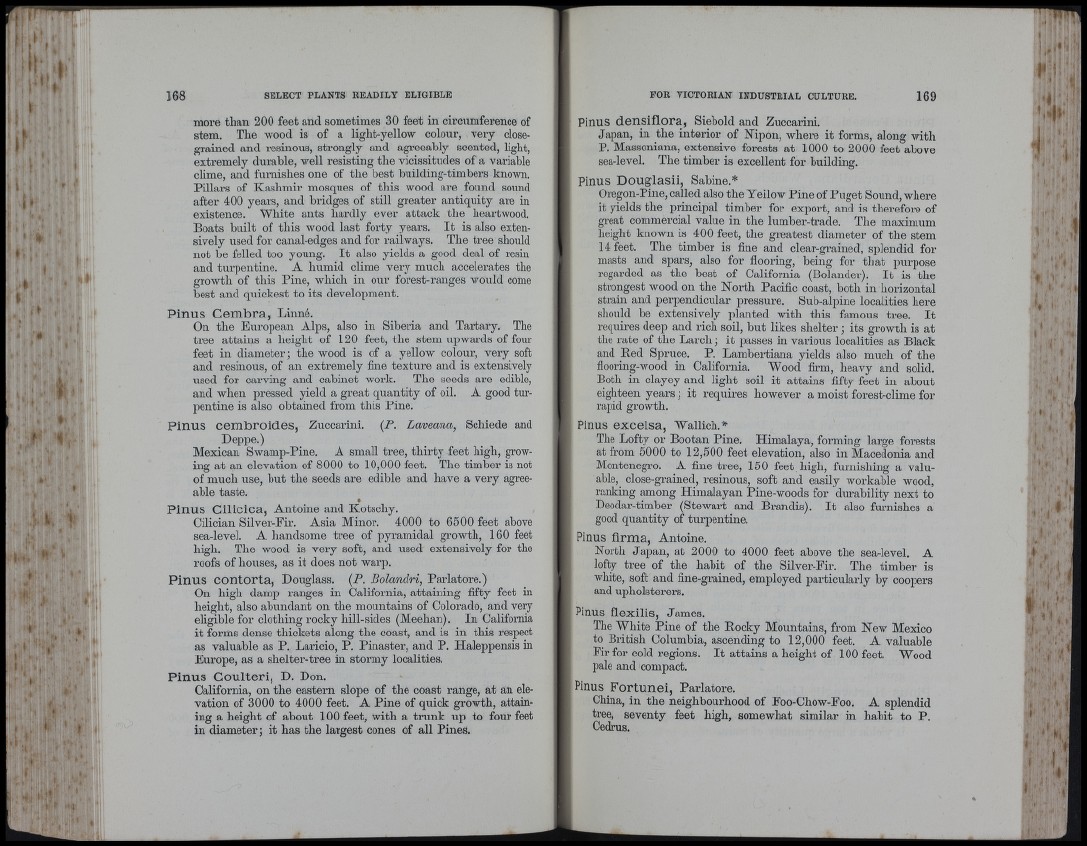
II ? {'• r .■ «i f»
I . i
, î - l , '
: i |q t l
j - - '
. 1. ?.
hij !■' i'< ' !‘
Í-
^ÍU I‘I
168 SELECT PLANTS READILY ELIGIBLE
more than 200 feet and sometimes 30 feet in circumference of
stem. The wood is of a light-yellow colour, very close-
grained and resinous, strongly and agreeably scented, light,
extremely durable, well resisting the vicissitudes of a variable
clime, and furnishes one of the best building-timbers known.
Pillars of Kashmir mosques of this wood are found sound
after 400 years, and bridges of still greater antiquity are in
existence. White ants hardly ever attack the heartwood.
Boats built of tins wood last forty years. I t is also extensively
used for canal-edges and for railways. The tree should
not be felled too young. I t also yields a good deal of resin
and turpentine. A humid clime very much accelerates the
growth of this Pine, which in onr forest-ranges would come
best and quickest to its development.
Pinus Cembra, Linné.
On the European Alps, also in Siberia and Tartary. The
tree attains a height of 1 2 0 feet, the stem upwards of four
feet in diameter; the wood is of a yellow colour, very soft
and resinous, of an extremely fine texture and is extensively
used for carving and cabinet work. The seeds are edible,
and when pressed yield a great quantity of oil. A good turpentine
is also obtained from tbis Pine.
Pinus cembroideSj Zuccarini. (P. Zaveana, Schiede and
Deppe.)
Mexican Swamp-Pine. A small tree, thirty feet high, growing
at an elevation of 8000 to 10,000 feet. The timber is not
of much use, but the seeds are edible and bave a very agreeable
taste.
Pinus Cilicica, Antoine and Kotschy.
Cilician Silver-Fir. Asia Minor. 4000 to 6500 feet above
sea-level. A liandsome tree of pyramidal growth, 160 feet
bigli. The wood is very soft, and used extensively for the
roofs of houses, as it does not warp.
Pinus contorta, Douglass. (P. Polandri, Parlatore.)
On high damp ranges in California, attaining fifty feet in
height, also abundant on the mountains of Colorado, and very
eligible for clothing rocky liill-sides (Meehan). In California
it forms dense thickets along the coast, and is in this respect
as valuable as P. Laricio, P. Pinaster, and P. Haleppensis m
Europe, as a shelter-tree in stormy localities.
Pinus Coulteri, D. Don.
California, on the eastern slope of the coast range, at an elevation
of 3000 to 4000 feet. A Pine of quick growth, attaining
a height of about 1 0 0 feet, with a trunk up to four feet
in diameter; it has the largest cones of all Pines.
FOR VICTORIAN INDUSTRIAL CULTURE. 169
pinus densiflora, Siebold and Zuccarini.
Japan, in the interior of Nipon, where it forms, along with
P. Massoniana, extensive forests at 1000 to 2000 feet above
sea-level. The timber is excellent for building.
Pinus Douglasii, Sabine.*
Oregon-Pine, called also the Yellow Pine of Puget Sound, where
it yields the principal timber for export, and is therefore of
great commercial value in the lumber-trade. Tlie maximum
height known is 400 feet, the greatest diameter of the stem
14 feet. The timber is fine and clear-grained, splendid for
masts and spars, also for fiooring, being for that purpose
regarded as the best of California (Bolander). I t is the
strongest wood on the North Pacific coast, both in horizontal
strain and perpendicular pressure. Sub-alpine localities here
should be extensively planted with this famous tree. I t
requires deep and rich soil, but likes skelter; its growth is at
the rate of the Larch; it passes in various localities as Black
and Bed Spruce. P. Lamhertiana yields also much of the
flooring-wood in California. Wood firm, heavy and solid.
Both in clayey and light soil it attains fifty feet in about
eighteen years; it requires however a moist forest-clime for
rapid growth.
Pinus excelsa, Wallich.*
The Lofty or Bootan Pine. Himalaya, forming large forests
at from 5000 to 12,500 feet elevation, also in Macedonia and
Montenegro. A fine tree, 150 feet high, furnishing a valuable,
close-grained, resinous, soft and easily workable wood,
ranking among Himalayan Pine-woods for durability next to
Deodar-timber (Stewart and Brandis). I t also furnishes a
good quantity of turpentine.
Pinus firma, Antoine.
North Japan, at 2000 to 4000 feet above the sea-level. A
lofty tree of tbe habit of the Silver-Fir. The timber is
white, soft and fine-grained, employed particularly by coopers
and upholsterers.
Pinus flexilis, James.
The White Pine of the Bocky Mountains, from New Mexico
to British Columbia, ascending to 12,000 feet. A valuable
Fir for cold regions. I t attains a height of 100 feet. Wood
líale and compact.
Pinus Fortunei, Parlatore.
China, in the neighbourhood of Foo-Chow-Eoo. A splendid
tree, seventy feet high, somewhat similar in habit to P.
Cedrus.
1» '
I , t'